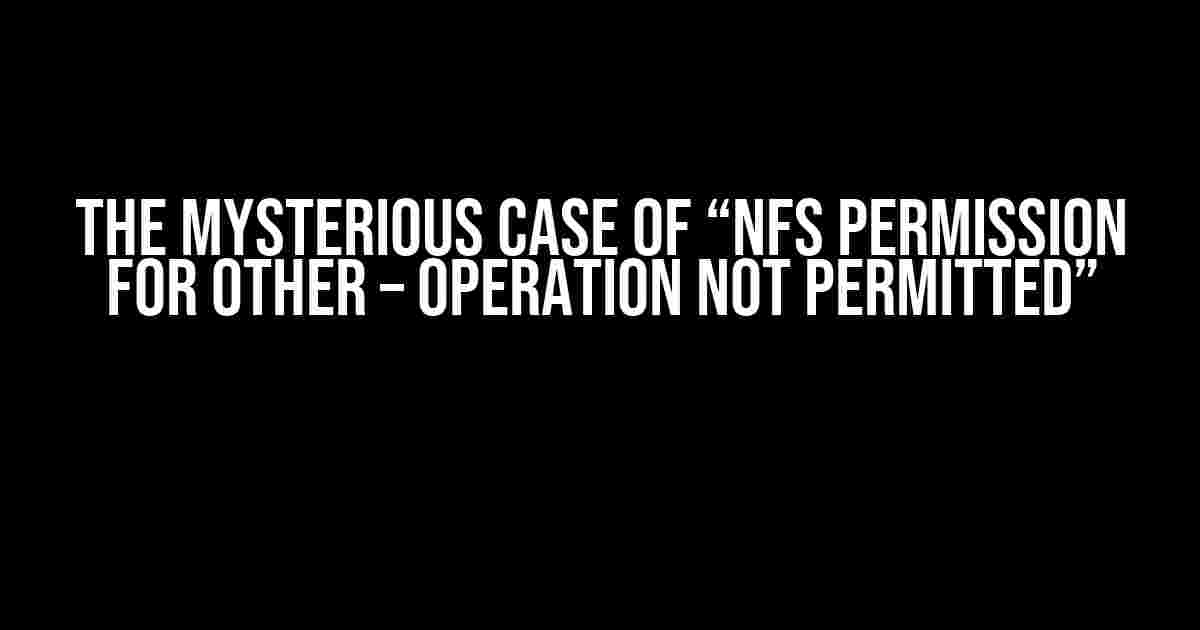If you’re reading this, chances are you’ve stumbled upon the frustrating error message “NFS permission for other – operation not permitted” while trying to access or modify files on a Network File System (NFS). Don’t worry, you’re not alone! In this article, we’ll delve into the world of NFS permissions, explore the causes of this error, and provide you with step-by-step solutions to overcome this obstacle.
What is NFS and How Does it Work?
Before we dive into the troubleshooting process, let’s quickly review what NFS is and how it works. NFS, or Network File System, is a protocol that allows different machines to share files over a network. It enables you to mount a remote file system as if it were local, making it easy to share files and collaborate with others.
The concept of NFS Permission
In an NFS environment, permissions play a crucial role in controlling access to files and directories. There are three types of permissions in NFS:
- User (U): Refers to the owner of the file or directory.
- Group (G): Refers to the group that the file or directory belongs to.
- Other (O): Refers to all other users on the system, excluding the owner and group members.
When you access an NFS share, your system checks the permissions to determine what actions you can perform on the file or directory. If the permissions are not set correctly, you might encounter errors like “NFS permission for other – operation not permitted.”
The Causes of “NFS Permission for Other – Operation Not Permitted” Error
Now that we have a basic understanding of NFS and permissions, let’s explore the common causes of the “NFS permission for other – operation not permitted” error:
- Incorrect Permission Settings: If the permissions on the NFS share are not set correctly, you might encounter this error. For example, if the “other” permission is set to 0 (no access), you’ll get this error.
- Root Squash: Root squash is a security feature that prevents the root user from accessing NFS shares with elevated privileges. If root squash is enabled, the “NFS permission for other – operation not permitted” error might occur.
- Mount Options: The way you mount the NFS share can also cause this error. For example, if you use the “noexec” or “nodev” options, you might encounter permission issues.
- SELinux or AppArmor Issues: If SELinux (Security-Enhanced Linux) or AppArmor is enabled on your system, it might interfere with NFS permissions, leading to the “NFS permission for other – operation not permitted” error.
Solutions to “NFS Permission for Other – Operation Not Permitted” Error
Now that we’ve identified the causes, let’s get to the solutions! Follow these step-by-step instructions to resolve the “NFS permission for other – operation not permitted” error:
Solution 1: Check and Adjust NFS Share Permissions
Use the following command to check the current permissions on the NFS share:
ls -ld /path/to/nfs/shareIf the “other” permission is set to 0, you can adjust it using the chmod command:
chmod o+rX /path/to/nfs/shareThis will grant read and execute permissions to the “other” group.
Solution 2: Disable Root Squash
To disable root squash, you’ll need to modify the NFS export options on the server-side. Edit the /etc/exports file and add the “no_root_squash” option:
/path/to/nfs/share 192.168.1.0/24(ro,async,no_root_squash)Then, restart the NFS service to apply the changes:
service nfs restartSolution 3: Adjust Mount Options
If you’re using the “noexec” or “nodev” options when mounting the NFS share, try removing them:
mount -o rw,async,noatime,nodiratime /path/to/nfs/share /mntInstead, use the “exec” and “dev” options to allow execution and device files:
mount -o rw,async,noatime,nodiratime,exec,dev /path/to/nfs/share /mntSolution 4: Disable SELinux or AppArmor
If you’re running SELinux or AppArmor, try disabling them temporarily to see if it resolves the issue:
setenforce 0or
aa-disable /path/to/nfs/shareRemember to re-enable SELinux or AppArmor once you’ve resolved the issue, as they provide important security features.
Conclusion
The “NFS permission for other – operation not permitted” error can be frustrating, but by following these solutions, you should be able to overcome it. Remember to carefully review your NFS share permissions, disable root squash if necessary, adjust mount options, and disable SELinux or AppArmor if they’re interfering with your NFS setup.
Additional Tips and Tricks
Here are some additional tips to keep in mind when working with NFS shares:
- Use a consistent UID and GID: Ensure that the UID and GID of the NFS share owner are consistent across all machines on the network.
- Set permissions recursively: Use the -R option with chmod to set permissions recursively:
chmod -R o+rX /path/to/nfs/shareThis will grant read and execute permissions to the “other” group for all files and directories within the specified path.
- Use NFSv4 instead of NFSv3: NFSv4 offers improved security features and is generally more reliable than NFSv3.
| NFS Version | Security Features |
|---|---|
| NFSv3 | No encryption, weak authentication |
| NFSv4 | Strong encryption, Kerberos authentication |
By following these tips and understanding the causes and solutions of the “NFS permission for other – operation not permitted” error, you’ll be well-equipped to tackle NFS permission issues and work efficiently with Network File Systems.
Frequently Asked Question
Get rid of the “NFS permission for other – operation not permitted” error and unlock the secrets of NFS permissions!
What does the “NFS permission for other – operation not permitted” error mean?
This error occurs when the NFS (Network File System) client tries to access a file or directory with insufficient permissions, resulting in an “operation not permitted” message. It’s like trying to unlock a door without the right key – you need the correct permissions to access the NFS share!
How do I set the correct NFS permissions to avoid this error?
To set the correct NFS permissions, you need to ensure that the NFS client has the necessary access rights to the shared files and directories. This can be done by setting the correct ownership and permissions on the NFS server, or by configuring the NFS client to use a specific username and password. Think of it like granting access to a secure room – you need to give the right person the right key!
What are the common causes of the “NFS permission for other – operation not permitted” error?
Common causes of this error include incorrect NFS client configuration, insufficient permissions on the NFS server, and mismatched username and password credentials. It’s like trying to open a combination lock without the right combination – you need to get all the pieces in place to access the NFS share successfully!
Can I use the `chmod` command to fix the NFS permission issue?
Yes, you can use the `chmod` command to change the permissions on the NFS share, but be careful! If you’re not careful, you might end up changing the permissions on the wrong files or directories. Imagine you’re trying to fix a delicate lock – you need to be precise and gentle to avoid causing more problems!
Are there any alternative solutions to resolve the NFS permission issue?
Yes, there are alternative solutions to resolve the NFS permission issue, such as using access control lists (ACLs), setting up a separate NFS export for each user or group, or using a different file system permission model. Think of it like finding a different key to unlock the door – sometimes you need to think outside the box to find the right solution!


